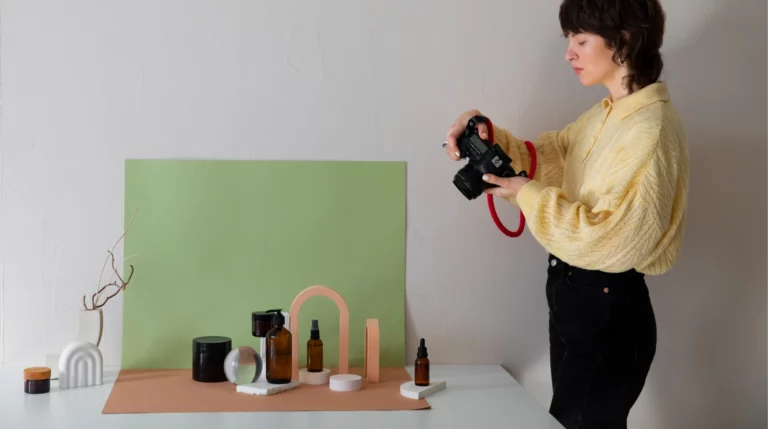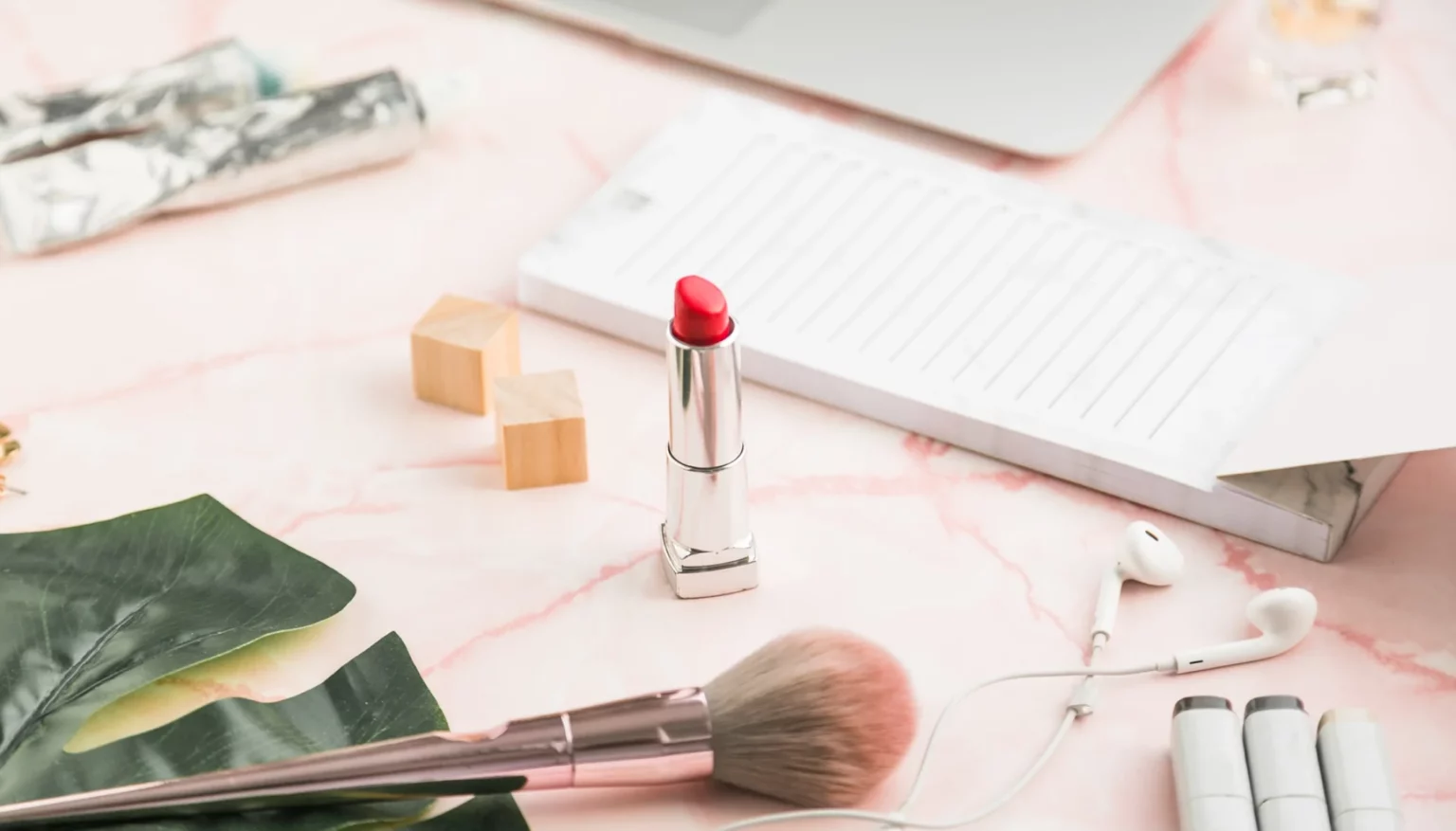Cosmetic products are an essential part of everyday life. You can see them everywhere, from stores to advertising, to digital stores. When shopping online, you rely on product photography to see what the item looks like instead of directly interacting with it like you can in real life. And while these images need to be as realistic as possible, there is another side to them – an artistic approach. Read the article and discover how the artistic approach in cosmetic product photography can improve your e-commerce business.
What is Creative Product Photography?
Creative photography is a photography technique that transforms ordinary moments into artistic expressions. You can think of it as a ‘superpower’ that turns a simple image into a unique, eye-catching one. When you apply the artistic approach to cosmetic product photography, the results are impressive and attention-grabbing. This, in turn, helps your business stand out from the competition, as the visuals create an unforgettable memory in your clients’ minds, making your brand recognizable.
The Power of Simplicity

When it comes to cosmetic product photography, less is more. A simple and neat composition allows the viewer to focus only on the beauty product, showing its features and benefits. Moreover, a minimalist style creates a feeling of elegance and sophistication, which boosts visual appeal. Also, the absence of distracting elements makes your brand look more refined and luxurious.
A simple and attractive design helps your product stand out in a crowded market. People prefer brands that embrace simplicity, while minimalist cosmetic photography conveys quality over quantity. So, how can you present this artistic approach in cosmetic product photography? Here are a few tips.
Emotions and Cosmetic Brand Loyalty
To stand out from your competition, you should provoke a positive yet long-lasting impression on your clients. And you can achieve this through an artistic approach to your cosmetic product photographs.
Use colors to your advantage and let your creativity loose. Play around with the shapes, colors, positions, and lighting. Are you showcasing lipstick? Take advantage of its color and create a complementary background that enhances the product even more.
Or maybe eyeshadows are your heroes, and in this case, you can use splashes of colors and patterns. Building an emotional connection with your clients will help them remember your brand and choose it for their online cosmetic shopping.
Show, don’t tell: A Story Through Images
Take an artistic approach and tell a story about your cosmetic product through product photography. You can convey a message or a mood that resonates with your target audience using visual cues. Using warm colors can express warmth and happiness while geometric shapes can suggest precision and quality.
Think about the way your eyes follow the image and use it to your advantage to showcase your products. Another method to present an emotion is by elevating the product. By doing this ‘the hero’ – your cosmetic product – will be the center of attention.
Building Trust
A high-quality and creative photography approach to your cosmetic products can help tell a visual story that resonates with your customers. By showcasing your products in the best possible light, you can highlight their beauty and value, making them more appealing to potential buyers. This also indicates that your brand is committed to quality.
Using realistic and appealing photos for your products also builds customer trust. They can see how the products look and work in real life, through authentic images, unlike generic or edited stock images, leading to more engagement and satisfaction from your customers.
Best Practices for an Artistic Approach in Cosmetic Product Photography

When it comes to creating a unique composition, there are a few elements you should pay attention to. These include the following:
- Plan it out. Before you start your photoshoot, plan how you wish the final image to look like. Experiment with different angles and composition elements before you decide on the finished look.
- Choose good colors. Color balance is essential for your product. A complementary background, in a similar tone to your product, will help create a vivid illustration. Or, if you wish to highlight the product, choose a paler shade for the background. You can also experiment with different shades and filters to match the mood and style of your minimalist beauty products.
- Include the swatches or packages. While clients love to see the product directly, you can also include the package in the image. Or, you can take it a notch higher and include a color swatch for it. This will help create different vibes, as well as interesting compositions while providing your customers with an in-depth view of the product.
- Clean the products. Before you begin the photo shoot, give the cosmetic item you plan on using a good cleaning. Wipe it with a soft cloth and use a cleaning solution. This way you can be sure the dust and fingerprints are removed beforehand. It will save time and money in the post-production process.
- Use macro lenses or tubes. While an artistic approach in cosmetic product photography makes use of the entire product, sometimes a close-up is beneficial. This works well to showcase the texture or with cosmetic products that have glitter in their composition, and you want to emphasize that.
- Gradient light. Another method to let your artistic side show in the images, is through a gradient, soft light. This type of lighting will create a soft shadow on the products, avoiding harsh lines, and making them more appealing to your customers.
- Depth of field. If your artistic image has a detailed background, you can play with the depth of field – the background blur – to make the cosmetic products stand out.
When you have taken care of all the details, and the pictures are ready, it is time for post-production editing. This process requires a software in which you can correct any mistake that sneaked into the photography session.
The most frequently used ones are Photoshop and Lightroom, but you can always use other software programs you are more familiar with. Also, you can consider going completely digital with the photo session using a CGI model. A 3D rendering of your cosmetic product will prove highly beneficial for your brand image, as well as marketing plans.
Technical Aspects

While creativity plays a crucial role in capturing artistic images of cosmetic products, it is equally important to have a good understanding of the technical aspects of photography. Lighting and camera are two of the most predominant elements to prioritize in any photo session, regardless of the subject. Therefore, the following tips focus on these two elements.
Camera
You can use any camera to photograph your subjects, even your smartphone. However, if you want to use a professional camera, there are three main settings to remember.
- Aperture – When taking a photo, your camera’s aperture setting determines how much light is allowed in. This setting is represented by a number followed by ‘f’. The higher the number, the less light enters the camera. A low or medium aperture setting works better for product photography. However, using a low aperture can lead to blurring, so it is vital to use a tripod to keep the camera steady.
- Shutter speed – The shutter speed determines how quickly the camera’s shutter closes and opens. In other words, it shows how quickly light enters the camera. A low shutter speed allows more light to enter the camera, while a high shutter speed restricts the light. Try it out and find the right setting for you.
- ISO – This setting determines the light sensitivity of your camera. A higher value results in more light being captured. This setting should be lower for product photography.
Lighting
When editing an image, lighting is often the principal cause of problems such as pale or too dark colors and washed-out tones. To avoid them, choose the right type of lighting from the start. Natural light is always the best option, but sometimes you will find yourself in need of using artificial lights. Here are some tips to help you choose the best lighting for your products.
Recognize the Tone
Everything has a prime color. But that prime color is heavily influenced by undertones. These undertones will play an essential role in adding more nuances to cosmetic products. For example, a household bulb has a warm tone, which translates into more yellow in the image. A fluorescent light, on the other hand, has a cold undertone, which will increase the cool nuances of the product. Always pay attention to the product and the vision when you choose your lighting.
Double Lights
When taking photos of your products, a single principal light is usually sufficient to provide the necessary lighting for a clear and precise image. However, in some cases, you may need to use a second light to achieve a specific artistic effect in your cosmetic product photography. Be sure to experiment with different angles and reflections to ensure that the product remains the focus of the image rather than other elements in the frame.
Distance Yourself from the Subject
When lighting a cosmetic product, it is best to avoid placing the light source too close to it. Instead, take a few steps back to create distance between the product and the light source. This will help in the post-production phase and highlight the item’s contour and shadows. Diffused lighting works better than direct, and makes the product look more appealing.
Final Thoughts
Creative and artistic approaches in cosmetic product photography can help you showcase your products in a unique way, and attract the attention and interest of your potential customers.
Moreover, an artistic approach can also evoke emotions and feelings, and persuade your customers to take action. Creative and artistic approaches can also help you reflect your brand identity, message, and values and differentiate yourself from competitors.
FAQ
How do I edit my cosmetic product photos?
Editing is an essential step in cosmetic product photography that can help you enhance your images’ quality, appearance, and appeal. You can edit your photos using various software or apps, such as Photoshop, Lightroom, Snapseed, or VSCO.
How do I choose the best camera for cosmetic product photography?
You must consider your budget, skill level, and purpose to choose the best camera for cosmetic product photography. However, some standard features such as Auto-focus, high resolution, and RAW format are the main features you should look for.
Why is storytelling important in cosmetic product photography?
Storytelling creates an extra layer of depth to your cosmetic product photography by making a meaningful and memorable experience for your audience. It helps your products stand out in a competitive market by giving them background and value, making them more than just a product on the shelf.



